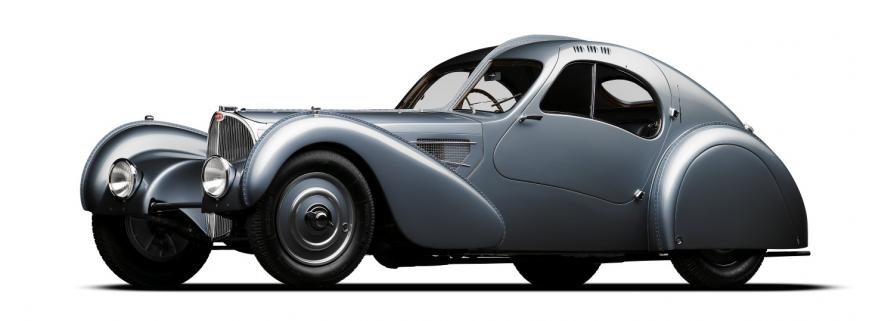1936 Bugatti Type 57SC Atlantic

The descriptions of the Classic Cars in the Directory were partly generated or supplemented with the help of artificial intelligence (AI). The content may occasionally not always be entirely accurate or factually correct despite careful checking.
The Bugatti Type 57SC Atlantic 1936 is a truly stunning vehicle that boasts a number of impressive technical features. First and foremost, this car is known for its incredible power and speed, which are made possible by its advanced engine and drivetrain.
Under the hood, you'll find a supercharged 3.3-liter inline-eight engine that produces a whopping 200 horsepower. This engine is mated to a four-speed manual transmission that provides incredibly smooth and precise shifting. Additionally, the car features a hydraulic brake system that ensures reliable stopping power even at high speeds.
One of the most impressive features of the Bugatti Type 57SC Atlantic 1936 is its aerodynamic design. The car was built with an eye towards maximizing speed and efficiency, with a long, sleek body that cuts through the air with ease. This design is further enhanced by the use of lightweight aluminum body panels, which help to reduce weight and improve handling.
In terms of suspension and handling, the Bugatti Type 57SC Atlantic 1936 is equipped with a number of high-performance components. The car features a four-wheel independent suspension system that uses both coil springs and hydraulic shocks to provide a smooth ride and excellent handling. Additionally, the car is fitted with massive drum brakes that provide dependable stopping power in all driving conditions.
Inside the car, you'll find a luxurious and well-appointed cockpit that is equipped with all the latest technology and features. The car's dashboard is fitted with a full range of gauges and dials that provide detailed information on the car's vital signs, while the seats are upholstered in rich, luxurious leather for maximum comfort and support.
Overall, the Bugatti Type 57SC Atlantic 1936 is one of the most impressive and technically advanced cars ever built. From its powerhouse engine and advanced suspension system to its sleek and aerodynamic design, this car is a true masterpiece of automotive engineering.
Milestones
- Bugatti Type 57SC Atlantic was first introduced at the 1936 Paris Auto Show. - Only four examples of the Type 57SC Atlantic were ever made, each unique in its own right. - The car featured a low roofline, prominent dorsal seam, and stunning proportions that made it a hallmark of Art Deco design. - The bodywork of the car was made entirely out of aluminium, which was an innovative material for a car at the time. - The Type 57SC Atlantic was powered by a 3.3-liter inline-eight engine that produced around 200 horsepower. - Jean Bugatti, the son of Bugatti founder Ettore Bugatti, designed the Type 57SC Atlantic and was heavily involved in its production. - The car's cost was roughly $40,000, which was an exorbitant amount of money at the time. - One of the original four Type 57SC Atlantics was lost during World War II, and another was destroyed in a crash in 1955. - Ralph Lauren, an American fashion designer and car collector, owns one of the two surviving Type 57SC Atlantics and considers it to be one of his proudest possessions. - The Type 57SC Atlantic remains one of the most coveted and valuable cars in the world, with one example selling for over $40 million in 2010.Technical
- Engine: 3,257 cc DOHC inline-eight engine - Horsepower: 200 hp at 5,000 rpm - Top Speed: 200 km/h (124 mph) - Transmission: Four-speed manual gearbox - Suspension: Solid front axle with semi-elliptic leaf springs and live rear axle with reversed quarter-elliptic leaf springs - Brakes: Cable-operated four-wheel hydraulic drum brakes - Body: Hand-built aluminum body with prominent dorsal seam - Dimensions: Length - 4,600 mm (181 in); Width - 1,680 mm (66 in); Height - 1,374 mm (54 in) - Wheelbase: 2,979 mm (117 in) - Weight: 1,160 kg (2,557 lbs) - Production: Only four examples were produced, with three still surviving today.